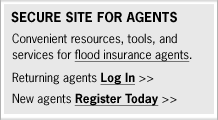
Risk Assessments
Why do I need flood insurance if I live on a hill and will never get flooded?
Why does the risk assessment tool say I’m in a high-risk area when the ground my home is built on is very high?
My community has never been flooded. Why do I show up in a low-to-moderate risk area?
Why does my address not show up in your database?
Why does my risk show up as “undetermined”?
Do insurance companies or agents use this tool to determine premium rates?
Where can I find more information on the maps that were used to determine my relative risk level?
Don't see your question? Go to the NFIP’s Answers to Questions
Why do I need flood insurance if I live on a hill and will never get flooded?
Floods can occur in any area, although to varying degrees. If you live on a hill or in an area that has never been flooded, your risk may be significantly reduced, but it is not eliminated.
Flooding can be caused by heavy rains, melting snow, inadequate drainage systems, failed protective devices such as levees and dams, as well as by tropical storms and hurricanes. Please make an informed decision about the flood risks you face before deciding not to purchase flood insurance. Talk to your agent for additional details – you may qualify for a Preferred Risk Policy (a lower-cost flood insurance policy).
Why does the risk assessment tool say I’m in a high-risk area when the ground my home is built on is very high?
Flood Insurance Rate Maps (FIRMs) cannot reflect every variation in the physical geography of an area. Therefore, a FIRM occasionally will show a property as being in a Special Flood Hazard Area (SFHA), even though the building may be above the Base Flood Elevation (BFE).
However, there is a mechanism for resolving such a situation. A property owner can submit property and elevation materials in support of a request for a Letter of Map Amendment (LOMA) to remove the property from the SFHA. This process involves the property owner and Federal Emergency Management Agency (FEMA).
For detailed information regarding the LOMA process, call toll free at 1.877.336.2627.
My community has never been flooded. Why do I show up in a low-to-moderate risk area?
Everyone lives in a flood zone. The fact that a flood hasn't occurred within recorded history does not mean one hasn't happened in the past or that one will not happen in the future.
It’s important to note that flood history is only one element used in determining flood risk. More critical determinations are made by evaluating your community’s rainfall and river flow data, topography, wind velocity, tidal surge, flood control measures, building development (existing and planned) and community maps.
Why does my address not show up in your database?
Our data comes from maps that are available in a digital format. Most communities are mapped; however yours may not be digitally available at this time. FEMA is currently facilitating a national effort to update and digitize all maps. Learn more about flood hazard mapping
Why does my risk show up as “undetermined”?
Undetermined risk typically occurs in sparsely populated areas and means that a flood hazard analysis has not yet been conducted. Your agent can help you determine your risk level and give you more information on coverage that will be right for you.
Do insurance companies or agents use this tool to determine premium rates?
No. This tool was created to help you understand your relative risk level, which is one only element used to determine your premium rates.
Along with flood zone information, agents will review location, the age and design of the building, occupancy, and the amount of coverage requested. Additionally, for buildings located in Special Flood Hazard Areas, agents must consider the elevation of the building in relation to the base flood elevation.
Where can I find more information about the maps that were used to determine my relative risk level?
FEMA publishes maps indicating a community's flood hazard areas and the degree of risk in those areas. Flood insurance maps usually are on file in a local repository in the community, such as the planning and zoning or engineering offices in the town hall or the county building.
In addition, you can order maps online or by writing, phoning, or faxing a request to the FEMA Map Service Center. There is a minimal charge for maps for most users.




500 C Street SW, Washington, D.C. 20472
Disaster Assistance: (800) 621-FEMA, TTY (800) 462-7585
U.S. Department of Homeland Security
FEMA Home | Contact FEMA |
Privacy Policy | Important Notices |
FOIA | USA.gov | DHS
